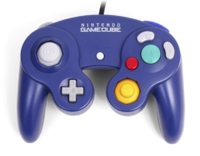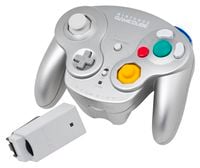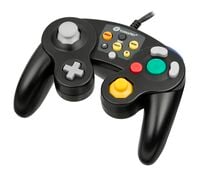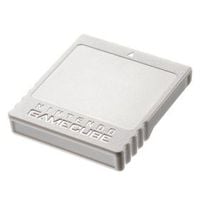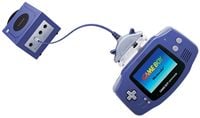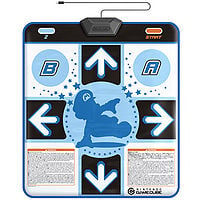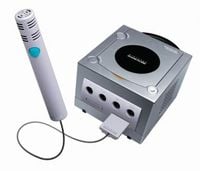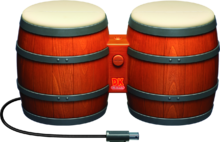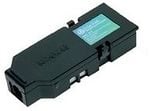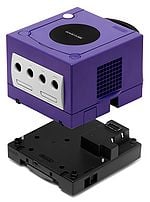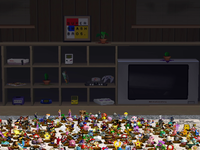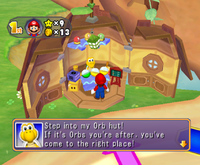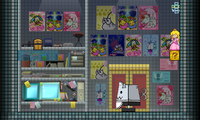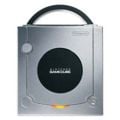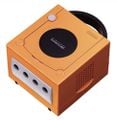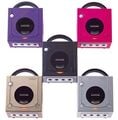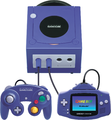Nintendo GameCube
- This article is about the video game system. For the Battle mode stage in Mario Kart: Double Dash!! of the same name, see Nintendo GameCube (battle course). For the treasure based off the system from Wario World, see List of treasures in Wario World § Pecan Sands.
| Nintendo GameCube | |
|---|---|
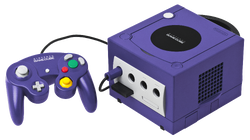
| |
| Generation | Sixth generation |
| Release date | Template:Release |
| Discontinued | Template:Release |
| Predecessor | Nintendo 64 |
| Successor | Wii |
Template:Quote2 The Nintendo GameCube is a home console system developed by Nintendo, and released in late 2001 as the successor of the Nintendo 64. The console's code name during preproduction was "Project Dolphin": this name is alluded to in many GameCube games, such as Wave Race: Blue Storm and Super Mario Sunshine. The Nintendo GameCube has six ports on its front: four controller ports (like the Nintendo 64) and two memory card ports. It has three buttons on top: Open, Reset, and Power. On the bottom are two serial ports and one hi-speed port for add-on expansions. The system uses proprietary 8 cm Game Discs based on the MiniDVD format that are able to hold up to 1.5 GB (1,459,978,240 bytes), making it the first Nintendo console to use optical discs as the primary storage medium. The use of a proprietary format rather than the industry standard 12 cm DVD format is commonly believed to be both an attempt to curtail piracy and a way to avoid paying a royalty fee to the DVD Forum, of whom Nintendo's competitor Sony is a member. The GameCube was the first Nintendo home console to have a startup screen in all international releases. It was also the first Nintendo home console since the Family Computer not to have a Super Mario game as a launch title, as Super Mario Sunshine was not released until a year after the system launched.
The Nintendo GameCube was released in five colors: Indigo, Black, Orange, Silver, and Gold. Indigo is the original color seen in advertisements, as well as the GameCube's trophy in Super Smash Bros. Melee and its appearances in various other Nintendo games. Silver was released after the first three colors. Orange was not available in North America, but controllers matching its color were. A Hot Pink variant was announced at SpaceWorld 2000, but was never released.
In Japan, the GameCube is abbreviated as both "NGC" and "GC", as "NGC" is also an abbreviation used by the Japanese electronics company NGC Corporation.[1] In North America and Europe, the GameCube is abbreviated as "GCN", as the abbreviation "NGC" is trademarked by the National Geographic Channel.
The Nintendo GameCube was officially discontinued in 2007.
Menu
If the player holds ![]() while the GameCube logo is displayed on-screen, it will rotate and its sides will turn into tiles, giving the player immediate access to the main menu, even if there is a disc in the console. The music played on the GameCube menu is a slowed-down version of the Family Computer Disk System's startup tone.[2]
while the GameCube logo is displayed on-screen, it will rotate and its sides will turn into tiles, giving the player immediate access to the main menu, even if there is a disc in the console. The music played on the GameCube menu is a slowed-down version of the Family Computer Disk System's startup tone.[2]
By holding down certain buttons on the GameCube controller after the console is powered on, different sound effects will play when the GameCube logo is displayed during the console's startup animation. Holding down ![]() on one controller causes a xylophone to play, followed by a "boing" noise, then a child's laughter. Holding down
on one controller causes a xylophone to play, followed by a "boing" noise, then a child's laughter. Holding down ![]() on all four controllers causes a kabuki shout to play, followed by woodblocks, then a whoop, and finally a "ding" from a triangle.
on all four controllers causes a kabuki shout to play, followed by woodblocks, then a whoop, and finally a "ding" from a triangle.
Accessories and peripherals
Nintendo GameCube Controller
The Nintendo GameCube Controller is the system's standard controller. In addition to standard ![]() and
and ![]() buttons and a
buttons and a ![]() control stick, the Nintendo GameCube is the first Nintendo system to include a second analog stick known as the
control stick, the Nintendo GameCube is the first Nintendo system to include a second analog stick known as the ![]() C-Stick, located on the bottom right side of the controller. This analog stick replaces the C-buttons found on a Nintendo 64 controller. The controller features analog triggers
C-Stick, located on the bottom right side of the controller. This analog stick replaces the C-buttons found on a Nintendo 64 controller. The controller features analog triggers ![]()
![]() on the left and right sides of its back, and a single small shoulder button
on the left and right sides of its back, and a single small shoulder button ![]() on the right. The controller features a built-in rumble motor, carried over from the Nintendo 64's Rumble Pak add-on. Unlike the Nintendo 64 controller, the GameCube Controller features
on the right. The controller features a built-in rumble motor, carried over from the Nintendo 64's Rumble Pak add-on. Unlike the Nintendo 64 controller, the GameCube Controller features ![]() and
and ![]() buttons, as well as only two grips instead of three. The
buttons, as well as only two grips instead of three. The ![]() directional pad on the Nintendo GameCube Controller has the same size and shape as the directional pad on the original Game Boy Advance.
directional pad on the Nintendo GameCube Controller has the same size and shape as the directional pad on the original Game Boy Advance.
A wireless variant of the Nintendo GameCube controller known as the WaveBird Wireless Controller is also available. It connects to the system via a radio sensor that plugs into one of the system's controller ports. However, the WaveBird does not support the rumble feature that the standard controllers have.
Another variant, as part of the LodgeNet service, was exclusive to hotels.[3]
The Nintendo GameCube controller can also be used to play several Wii titles, including Mario Kart Wii and Super Smash Bros. Brawl as well as most Virtual Console titles. In addition, through use of the GameCube Controller Adapter for Wii U, the controller can be used to play Super Smash Bros. for Wii U. The accessory was released alongside an official Super Smash Bros.-themed GameCube controller. As of update 4.0.0, the GameCube Controller Adapter for Wii U and the controller itself can be used on the Nintendo Switch, the latter of which is treated as a Nintendo Switch Pro Controller except within certain games that specifically detect it; unlike on the Wii U, however, the controller can be used in all Switch games.
Memory Card
- Main article: Memory Card
The Nintendo GameCube used proprietary memory cards to save data for games (making the GameCube the first Nintendo console that required memory cards to save game data). Nintendo released three color variants, each of which contain varying block capacities: gray, black, and white, which could each hold 59, 251, and 1019 blocks of game data, respectively. The boxes for GameCube games have memory card holders which can be used to store a memory card in the box along with the Game Disc.
Nintendo GameCube–Game Boy Advance Link Cable
The Nintendo GameCube–Game Boy Advance Link Cable allows for a Game Boy Advance to be connected to the Nintendo GameCube, similar to the Transfer Pak released for the Nintendo 64. The cable can be used in numerous GameCube games to unlock special content, such as Wario World, which utilizes the cable for sending microgames from WarioWare, Inc.: Mega Microgame$! to the Game Boy Advance. The cable is also compatible with the Game Boy Player, with which the Game Boy Advance can be used as a controller for Game Boy Advance games being played on the GameCube.
| GameCube game | Game Boy Advance game | Features |
|---|---|---|
| Game Boy Player | N/A | The GBA can be used as the controller instead of the GameCube controller. |
| Mario Golf: Toadstool Tour | Mario Golf: Advance Tour | Unlocks new content and transfers game progress. |
| Mario Kart Double Dash!! Bonus Disc | Fire Emblem | Unlocks exclusive items that can be obtained only from the bonus disc. Also unlocks the soundtracks 99 & 100. The GBA link option is absent in the European version of Fire Emblem, since the Bonus Disc was not released in Europe. |
| Nintendo GameCube Preview Disc | N/A | Used to play downloadable games WarioWare, Inc.: Mega Microgame$! and Dr. Mario. |
| Nintendo Puzzle Collection | N/A | Used as a controller. Can also be used to download the NES version of Dr. Mario and Yoshi along with a GBA port of Panel de Pon. |
| Wario World | N/A | Sends a demo version of WarioWare, Inc.: Mega Microgame$! to the GBA. |
| WarioWare, Inc.: Mega Party Game$! | N/A | The GBA can be used as the controller instead of the GameCube controller. |
Nintendo GameCube Action Pad
The Nintendo GameCube Action Pad is a dance pad controller released by Konami and packaged with Dance Dance Revolution: Mario Mix, the only game it is compatible with on the system. The pad only features eight buttons: the directional inputs, the ![]() and
and ![]() buttons next to the up button, and the
buttons next to the up button, and the ![]() and
and ![]() buttons on the top corners of the pad. Two versions of the pad were released.
buttons on the top corners of the pad. Two versions of the pad were released.
Names in other languages
| Language | Name | Meaning | Notes |
|---|---|---|---|
| Chinese (traditional) | 跳舞墊[4] Tiàowǔ Diàn |
Dancing Mat |
Nintendo GameCube Microphone
The Nintendo GameCube Microphone is a special accessory used for Nintendo GameCube games on the GameCube or a backwards-compatible Wii. It is unusual in that it is plugged into a Memory Card slot rather than a controller slot. It has been used in Mario Party 6 and Mario Party 7 as a tool for playing Mic minigames and making Mic Spaces functional. As the Mic was intended to be used specifically with the GameCube, it is not compatible with any Wii games.
DK Bongos
The DK Bongos are bongo-shaped GameCube controllers primarily intended for use with the Donkey Konga series and Donkey Kong Jungle Beat. The controller is symmetrical, and each side is shaped like Barrel with a rubber drum skin fastened on top. It has a Start/Pause button in the center, along with the "DK" logo. DK Bongos even have a built-in microphone to detect clapping (although hitting the sides of it also functions). Each Barrel represents left or right on the GameCube's directional stick, based on how Donkey Kong moves left and right in Donkey Kong Jungle Beat. The DK Bongos are backward-compatible from the GameCube controller ports of the Wii. They are also usable from the GameCube Controller Adapter for the Wii U and Nintendo Switch.
In Japan, the controller is called the 「タルコンガ」TaruKonga (or "TaruConga") controller. The name is a multilayered pun, combining taru (the Japanese word for "barrel"), kon, or "con" (a suffix used by Namco when naming their original peripherals, such as the "GunCon", or the "TaTaCon"), and "Konga" (or "Conga").
Before Donkey Kong Barrel Blast's release on the Wii, it was originally developed for the GameCube with the title DK Bongo Blast. It would have been the fifth title to use the DK Bongos (fourth if excluding the Japan-exclusive Donkey Konga 3). The DK Bongos are also incompatible with New Play Control! Donkey Kong Jungle Beat, a port of Jungle Beat on the Wii.
The DK Bongos are the main feature of Konga Beat, which is Donkey Kong's Final Smash in Super Smash Bros. Brawl and Super Smash Bros. for Nintendo 3DS and Wii U.
Names in other languages
| Language | Name | Meaning | Notes |
|---|---|---|---|
| Chinese (traditional) | 康加鼓[4] Kāngjiāgǔ |
Konga |
Nintendo GameCube Broadband Adapter
- Main article: Nintendo GameCube Broadband Adapter
The Nintendo GameCube Broadband Adapter is an add-on that allows players to connect their consoles via a local area network for system-to-system multiplayer. The device connects to the Nintendo GameCube by plugging into the bottom of the system. Only a few games were compatible with the adapter, including Mario Kart: Double Dash!!.
Game Boy Player
- Main article: Game Boy Player
The Game Boy Player is an add-on peripheral released in 2003 and allowing players to play Game Boy, Game Boy Color, and Game Boy Advance titles on their television screen through their Nintendo GameCube. The peripheral attaches to the bottom of the system, and requires a special disc in order to play any handheld titles. It is also capable of linking up to Game Boy systems and accessories, including the e-Reader and Game Boy Camera, and players can connect their Game Boy Advance systems to the Nintendo GameCube by use of the Nintendo GameCube - Game Boy Advance Cable to use their systems as a controller, though some games support the rumble feature included with the standard controller. During gameplay, players can bring up a menu with the ![]() button that allows them to scroll through various options, including setting the screen size, changing the border surrounding the game, changing the button mapping for a Nintendo GameCube controller, changing the screen filter, and setting a timer. Players can also select to change the cartridge from this menu without turning off the system.
button that allows them to scroll through various options, including setting the screen size, changing the border surrounding the game, changing the button mapping for a Nintendo GameCube controller, changing the screen filter, and setting a timer. Players can also select to change the cartridge from this menu without turning off the system.
Compatibility with future consoles
The original version of the Wii, the successor of the Nintendo GameCube, is mostly compatible with Nintendo GameCube hardware and software. Like the Nintendo GameCube, the Wii has 4 controller ports and 2 memory card slots which support all controllers, like the dance mat and microphone, though it does not support add-ons that attach to the console. Later revisions of the Wii, such as the Wii Family Edition and Wii Mini, would remove Nintendo GameCube support. The Wii U and Nintendo Switch are also not compatible with any Nintendo GameCube games, but Super Smash Bros. for Wii U and most Nintendo Switch games are compatible with the controllers through a special adapter. The GameCube controller is compatible with more consoles than any other Nintendo controller, with a total of four: GameCube, Wii, Wii U, and Nintendo Switch (as of its 4.0.0 update).
Appearances and references in Mario media
Super Smash Bros. Melee
The Nintendo GameCube is a trophy in Super Smash Bros. Melee. It also appears as the only platform for Luigi's Target Test, and can be seen in the background of the trophy room along with numerous other Nintendo consoles.
Mario Party series
Though a Nintendo GameCube does not actually appear in Mario Party 4, the Party Cube is a reference to the GameCube, and the rumble machine in the options screen is clearly based on the system. Additionally, a Nintendo GameCube can be seen inside the Orb huts of Mario Party 6 and Mario Party 7.
Wario World
One of the treasures in Wario World is a Nintendo GameCube. It is located in a pink chest at Pecan Sands.
Mario Kart: Double Dash!!
The Nintendo GameCube battle course in Mario Kart: Double Dash!! is a GameCube. This Nintendo GameCube logo can also appear at the bottom of the word "Mario Kart" on the five pointed star in Mario Circuit and Sherbet Land. The logo can also be seen on the billboards at Mushroom City.
Paper Mario series
In Paper Mario: The Thousand-Year Door, Lucky, the brown Bulky Bob-omb that runs the lottery in the west side of Rogueport, will mention the system's internal clock if the player attempts to cheat the lottery by changing the time.
In Super Paper Mario, Francis owns a GameCube which he keeps in his room with several other game systems.
WarioWare: Touched!
In WarioWare: Touched!, one of the falling objects during the credit reel is a Nintendo GameCube logo. In the microgame Game On, a Nintendo GameCube, its controller cable and a Game Disc can be seen. 9-Volt and 18-Volt play 36-Volt Man on a Nintendo GameCube.
Super Mario Galaxy
In Super Mario Galaxy, the logo of the console is used as a texture on Kamella's wand.
Yoshi's Woolly World
In Yoshi's Woolly World, there is a Yoshi design called GameCube Yoshi.
The Super Mario Bros. Movie
On the SMBPlumbing.com website created to promote The Super Mario Bros. Movie, clicking on the phone number plays the GameCube startup jingle.
Development
In October 1997, Ed McCracken, the CEO of Silicon Graphics, Inc., resigned from his position, causing Nintendo to reconsider their partnership with the company.[5]
In 1997, the company ArtX was founded by twenty graphics hardware engineers who had previously worked at Silicon Graphics, Inc., designing the graphics hardware of the Nintendo 64. In early 1998, ArtX approached Nintendo to become their new graphics provider. From 1998 to 2000, ArtX developed the graphics hardware and system logic for Nintendo's next home console.[6] At E3 1999, Nintendo of America Chairman Howard Lincoln announced their next-generation console that would follow the Nintendo 64, along with the console's code name, "Project Dolphin". In addition to ArtX, Nintendo also partnered with IBM, who created Dolphin's CPU processor, codenamed "Gekko".[5] In April 2000, ArtX was acquired by ATI Technologies, as the company desired to enter the home console market. By this time, the graphics processor for the GameCube, codenamed "Flipper", had already been mostly completed by ArtX, and was ready for production.[6]
On August 25, 2000, at a press conference in Japan, Nintendo revealed the official name of the console as the Nintendo GameCube.[7] The GameCube was released on September 14, 2001 in Japan, and on November 18, 2001 in North America.
Hardware specifications
- MPU ("Microprocessor Unit")*: Custom IBM Power PC "Gekko"
- Manufacturing process: 0.18 micron IBM copper wire technology
- Clock frequency: 485 MHz
- CPU capacity: 1125 Dmips (Dhrystone 2.1)
- Internal data precision : 32-bit Integer & 64-bit floating-point
- External bus: 1.3GB/second peak bandwidth (32-bit address space, 64-bit data bus 162 MHz clock)
- Internal cache L1: instruction 32KB, data 32KB (8 way) L2: 256KB (2 way)
- System LSI: Custom ATI/Nintendo "Flipper"
- Embedded frame buffer: Approx. 2MB sustainable latency : 6.2ns (1T-SRAM)
- Embedded texture cache: Approx. 1MB sustainable latency : 6.2ns (1T-SRAM)
- Texture read bandwidth: 10.4GB/second (Peak)
- Main memory bandwidth: 2.6GB/second (Peak)
- Pixel depth: 24-bit color, 24-bit Z buffer
- Image processing functions: Fog, subpixel anti-aliasing, 8 hardware lights, alpha blending, virtual texture design, multi-texturing, bump mapping, environment mapping, MIP mapping, bilinear filtering, trilinear filtering, anisotropic filtering, real-time hardware texture decompression (S3TC), real-time decompression of display list, HW 3-line deflickering filter.
Trophy information from Super Smash Bros. Melee
Reception
The Nintendo GameCube was not very successful when compared to its competitors, Sony's PlayStation 2 and newcomer Microsoft's Xbox, only outselling former rival Sega's Dreamcast which was discontinued in March 2001 (due to Sega's exit from the console market). The Wii outsold the GameCube's lifetime sales of 21.74 million in only 16 months. The GameCube also held the title of being Nintendo's least successful home console, up until the Wii U surpassed it in 2017 with its lifetime sales of 13.56 million units. Commonly cited reasons for the GameCube's unpopular sales include lack of third-party titles, lack of online, loss of Rareware (due to Microsoft buying them out after the release of Star Fox Adventures), using limited-capability proprietary discs instead of the industry-standard DVD format, missing genres within its library that rose to popularity during the 2000s, and a lack of DVD-Video playback (the latter of which was a major selling point for the PlayStation 2).[8] However, the GameCube's release was accompanied by that of the Panasonic Q; the result of a collaborative project between Nintendo and former rival Panasonic, the Q was capable of playing both GameCube games and DVD movies. It ended up failing due to the price of a Q being noticeably higher than that of a standard GameCube and separate DVD player combined, and as a result, was never released outside of Japan.
Gallery
- Gamecube Startup Screen.gif
The start-up animation
The Nintendo GameCube battle course in Mario Kart: Double Dash!!
The GameCube icon used to promote Super Mario 3D All-Stars
Media
| File info |
| File info |
| File info |
| File info |
Game gallery
- NPC.jpg
References
- ^ https://www.ngc.co.jp/company/company-profile
- ^ http://www.youtube.com/watch?v=u1m6j38CDOc
- ^ LodgeNet Game Controllers - Nintendo's Hotel Rental Service!|Nintendrew - YouTube
- ^ a b 社長提問 Wii 企劃 - Vol.2 Wii 遙控器篇 Nintendo HK. Retrieved September 26, 2021.
- ^ a b "A Dolphin's Tale: The Story of GameCube". Dromble Media. January 7, 2014. (Archived July 5, 2014 via Wayback Machine.) Retrieved July 15, 2022.
- ^ a b "ATI Discusses GameCube Graphics". IGN. October 30, 2001. (Archived June 19, 2022 via Wayback Machine.) Retrieved July 15, 2022.
- ^ Satterfield, Shane. "Nintendo's GameCube Unveiled". GameSpot. August 25, 2000. (Archived September 5, 2015 via Wayback Machine.) Retrieved July 15, 2022.
- ^ Anderson, C. Here's Why The Nintendo GameCube Failed. Goliath. Retrieved June 2, 2020.
| Nintendo GameCube games | |
|---|---|
| Super Mario franchise | Luigi's Mansion (2001) • Super Mario Sunshine (2002) • Mario Party 4 (2002) • Mario Golf: Toadstool Tour (2003) • Mario Kart: Double Dash!! (2003) • Mario Party 5 (2003) • Paper Mario: The Thousand-Year Door (2004) • Mario Power Tennis (2004) • Mario Party 6 (2004) • Dance Dance Revolution: Mario Mix (2005) • Mario Superstar Baseball (2005) • Mario Party 7 (2005) • Super Mario Strikers (2005) |
| Donkey Kong franchise | Donkey Konga (2003) • Donkey Konga 2 (2004) • Donkey Kong Jungle Beat (2004) • Donkey Konga 3 JP (2005) |
| Wario franchise | Wario World (2003) • WarioWare, Inc.: Mega Party Game$! (2003) |
| Other | Super Mario 128 (2000, demo) • Super Smash Bros. Melee (2001) • Nintendo Puzzle Collection (2003) • NBA Street V3 (2005) • SSX on Tour (Nintendo Village) (2005) • Donkey Kong Racing (cancelled) • Diddy Kong Racing Adventure (cancelled) |
